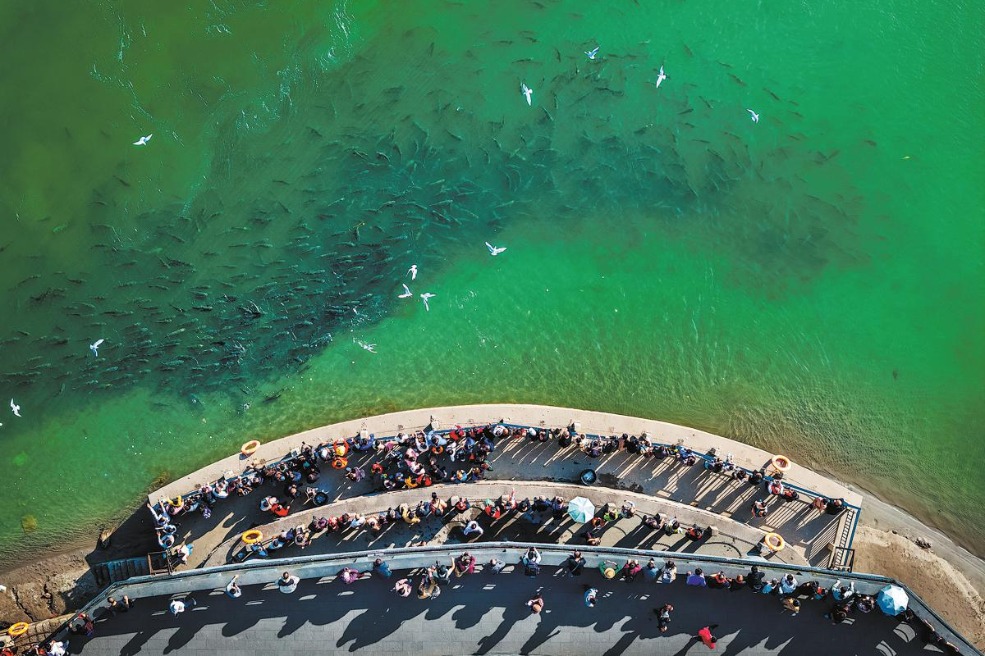Shore to find great flavors
A Beijing restaurant specializing in Lu cuisine, a complex culinary style from Shandong province, is offering up an array of regional delights centered around seafood, Li Yingxue reports.

Long renowned for being salty and heavily-sauced, Lu cuisine from Shandong province is one of the eight main cooking styles found in China. But one restaurant in Beijing, the aptly-named Lu Style, is now giving the time-honored culinary genre a fresh twist with a dash of modern fine-dining.
Born and raised in Qufu, Shandong province, executive chef Zhang Xiangdong believes that the origins of Lu cuisine derive from the complex dishes developed by private chefs hired to work in the mansions of Qing Dynasty (1644-1911) officials combined with the seafood dishes found on the Jiaodong Peninsula.
"The food is not always dark in color. Lu cuisine actually highlights the flavors of the ingredients and requires a lot of sophisticated cooking skills," Zhang says.
All the dishes at Lu Style typically capture the essence of the culinary style of Northeast China-and Yimeng pancake with six sauces is just one example.
The six types of sauces are specialties from six regions of Shandong province-fried shrimp from Rizhao; a sauce made from the tender leaves of Chinese toon from Linyi; Spanish mackerel sauce from Weihai; chili sauce from Heze; minced salt and sesame sauce from Zaozhuang; and sliced pickles from Jining.
According to Zhang, the pancake is made using a mix of five different grains, before being cut into squares and plated up.
"I hope from this one dish, diners are able to sample the flavors of the different regions of Shandong," Zhang says.
Since seafood is the highlight of Lu cuisine, Lu Style offers a variety of different types to choose from-eight from Weihai alongside eight from the Jiaodong Peninsula.
The former includes sea cucumber, abalone and oyster, while the latter covers mostly shell fish such as whelks, snails and clams.
"Seafood is common on dinner tables in the Jiaodong region. We often braise the larger, more expensive seafood to highlight its original flavor, while for smaller fare, frying them in a spicy sauce is a more common way of cooking them-and one that pairs well with beer," Zhang explains.
Salt-coated peled is inspired by a traditional fish dish found in Lu cuisine and a regional method of making bread. A type of white freshwater fish, the peled are shipped in from Sailimu Lake in the Xinjiang Uygur autonomous region, and have a tender and delicate texture and flavor like tofu.
The fish is simply coated with salt before it's baked. When it's served, the salty coating cracks open to reveal the fresh, juicy meat of the fish.
Sea cucumber is a dish that is nourishing, but one that's also difficult to cook. At Lu Style, sea cucumber soup and braised sea cucumber with leeks are both signature dishes.
All the sea cucumbers served at Lu Style are sourced from the wild and are over three years old. According to Zhang, they harvested at a depth of 20 meters and are plump with strong spines.
Only salt is added to the sea cucumber soup as seasoning, so the umami of the soup comes purely from the sea cucumber. The deep green color of the soup comes from the seaweed that sea cucumber eats, its only source of sustenance.
Donkey meat is not a common ingredient in Chinese cooking, but something of a regional delicacy in Shandong. Lu Style sources the meat from animals culled at the age of around 2 years old.
"The donkey's skin, meat and milk are all nutritious, and donkey meat is one of the main ingredients found in Lu cuisine," Zhang says.
Donkey gelatin soup with fermented black garlic is a typical winter treat. The first step in creating the sweet and salty soup is to boil the donkey meat and gelatin for 12 hours at a low heat, before the black garlic is added and then cooked for a further four hours.
All the flavors of the meat, gelatin and black garlic infuse in the glutinous soup base to create a distinctively warming dish-and one for which Lu Style has applied for a national patent.
Donkey hoofs are another specialty of the restaurant that have rich nutritional value, as does their signature yogurt dish, which is made from donkey milk.
Zhang and his team take a lot of effort to source the best ingredients. From the mushrooms from Jilin province and the potatoes from the Inner Mongolia autonomous region to the clams from South Korea and scallops from Japan, each ingredient is carefully selected.
There are four ingredients that are considered the freshest in rural China-the tender leaves of the deciduous Chinese toon tree, the first batch of Chinese chives, cucumbers with the flower left on and lotus roots picked after their flowers drop off.
To find the best first batch of Chinese chives, chefs from Lu Style visited seven provinces before finally sourcing the freshest ones grown in Mudanjiang, Heilongjiang province.
"The Chinese chives there grow in black soil with an 80 percent humidity, and they are planted around 15 centimeters apart to maximize their exposure to the sun," says Zhang.
Just as culinary staples are a highlight of Lu cuisine, they also feature prominently at Lu Style. Pot-braised noodle soup is another must-try.
"It looks like a simple dish but the timing of when to add the water is crucial and tests the skill of the chef," he says. "The leeks must be fried in hot oil until they just start to burn, and then water and the noodles are added to the pot. If it's done too early, the aroma of the leeks will not shine through, and if it's too late the leeks will simply burn."
All the noodles are handmade by the restaurant's pastry chef. According to Zhang, the pastry chef cuts each noodle to exactly the same width. "Sometimes, I have to ask the chef not to cut them so precisely as it makes the noodles look like they were made using a machine," he says.
There are two other dishes that are well worth trying: dumplings with a sea urchin filling, and steamed buns with dried green beans, fresh scallop and diced black pork.
The restaurant was awarded with a Michelin Plate in November, one of just three Lu cuisine restaurants listed in the Michelin Guide Beijing 2020.
The logo of Lu Style hanging above the entrance is also eye-catching. Created by Hong Kong designer Hon Bing-wah, the logo is based on the Chinese character lu-an abbreviation of "Shandong province"-which looks like a sail on the sea, passing the sun.
A twisting pine tree greets the guests, representing the warmth and hospitality of the people of Shandong.
From the names on the private dining rooms to the interior decor, the design of the restaurant has been clearly inspired by the ancient Chinese classic, The Book of Songs.
The book unites the two floors of the interior space-the ceiling is made from poems in the book, while each of the steps is made of book spines.
Zeng Hui, deputy director of Beijing Design Week's organizing committee, was the design consultant for Lu Style. He published a book, The Life Aesthetics of Lu Style, in December 2018.
"Lu Style, a museum of life aesthetics in catering, is shortening the distance between food and art," Zeng wrote in the book. "Even though each cuisine has its own beauty, the beauty of Lu Style is that it combines all the flavors found in Chinese cuisine."
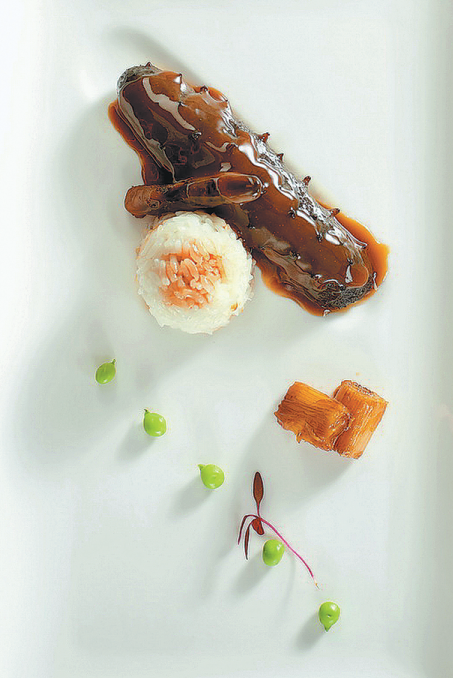
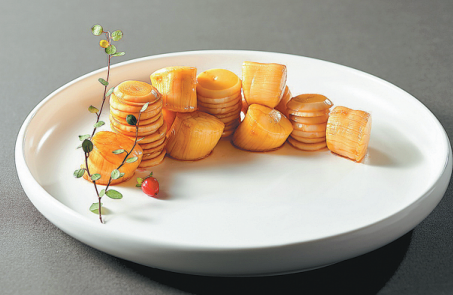
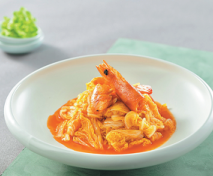
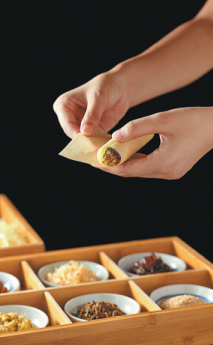
Today's Top News
- SCO summit poised for fruitful outcomes
- Steps to spur consumption, enhance vitality
- Flag patterns for four branches of PLA unveiled
- China seeks to deepen dialogue, consultations with US
- Pacific Ocean should not be turned into a sea of zero-sum disturbances: China Daily editorial
- Xi signs order to commend military units, individuals



















